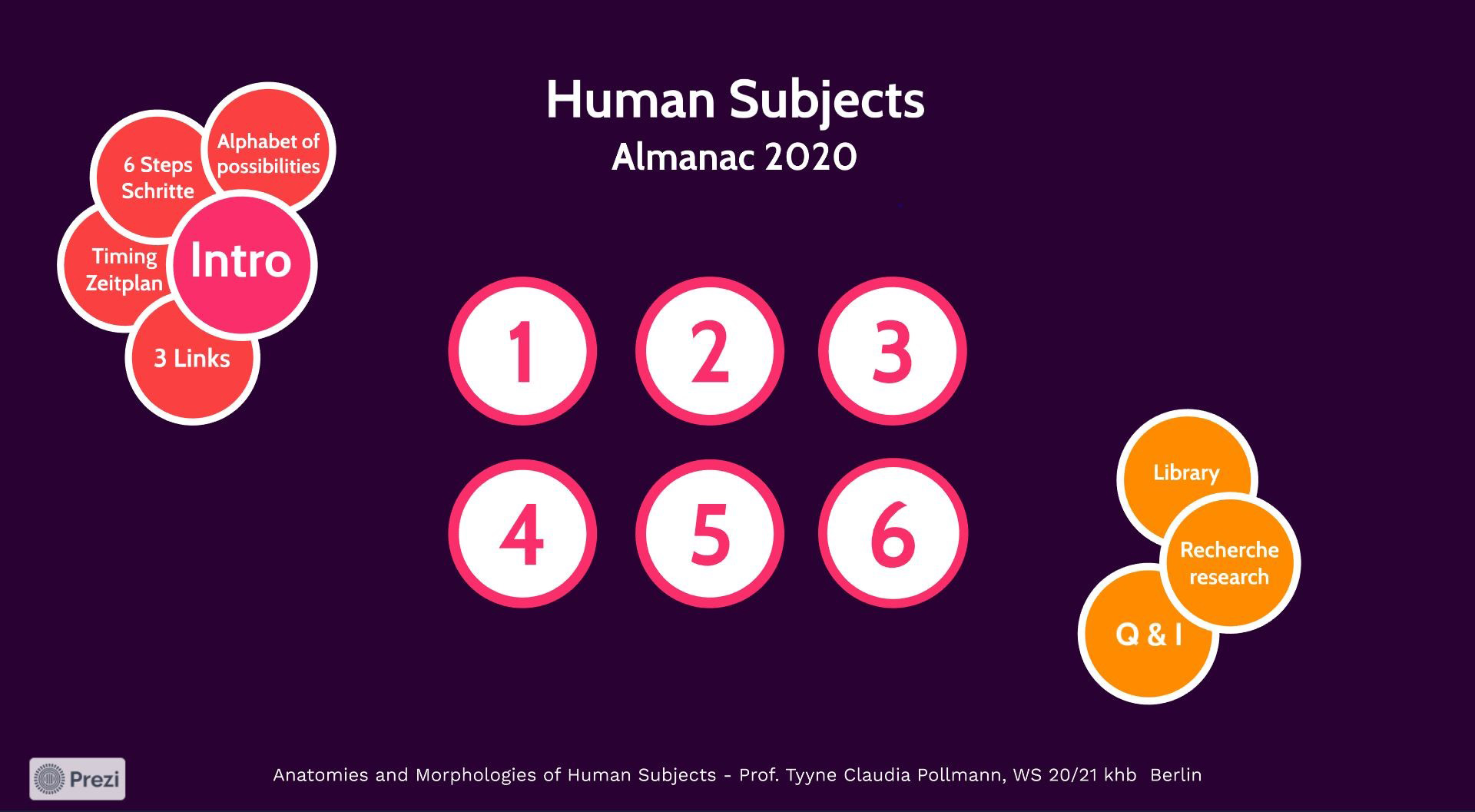The title refers to the human subjects as issues that emerged during the year 2020 and concerns the human subjects as being both initiators and victims of their anthropocentric makings. The heart of the project were 7 questions to anonymously comment on the “year 2020”, a deliberately vague term, to enable a wide spectrum of responses. This an-alphabet, created by 103 students, was the source material, from which each student could choose a topic, to generate an individual artistic outcome. Thus, the decision-making process moved to the students.
One of the outcomes of this course is the joint production of the an-alphabeth
More about Human Subjects
The 103 first semester students started their studies in a hybrid mode, but in view of the hard lockdown we switched to an entirely online mode. Berlin incidences had skyrocketed, and vaccination was not in sight. An unusually high proportion of the 103 students reported being frightened and insecure in the face of the pandemic situation and increasingly sought out the offer of individual online support, which I had offered on an ad hoc basis due to the need*. For most of our students, the start of the first semester means moving in winter to an unfamiliar big city, without social or family contacts, usually to a one-room apartment. The possibilities of social contact were now eliminated and only took place via online platforms, which was a stressful experience for many. In addition, artistic work is intensively concerned with space, the presence of materials and media, all of what was now missing out. The students started working with whatever they could find in their flats.
The students also decided about the media and genres that would embody their concepts. Intense discussions commenced. Other students struggled with deciding on a topic and genre, as they were not used to making decisions, but rather expected to be given tasks to fulfill, as they had done for so many years in school.
The challenge was to make ground for experiences, agency and research to take place and thus allow new avenues and options for knowledge production. Despite the multitude of political and socially explosive topics that were mentioned, the artistic contributions mainly referred to student’s own states of mind during the lockdown.
You will find two videos as examples; both works were produced during the hard lockdown in the author’s own apartments.
[ * I hold a psychotherapy certificate]
Human Subjects_original course info
Human Subjects 2020
Dear students,
welcome to the course Anatomy and Morphology!
We start together into a hybrid semester. I tried to minimize the technical challenges and prepared a presentation in which you will find an intro and all necessary links and tools. During the whole course you only need this link to find your way around:
The content will be dedicated to a project with the working title Human subjects 2020. While human quite clearly denotes a human component, the term „subject“ can be read in different ways: it means topic, question or area, but also the patient or subject that is part of an investigation, and in grammar the active subject. In addition, in the Anthropocene, the human being often finds him/herself in the dual role of perpetrator and victim at the same time, since his/her actions cause disparities and, at the same time, he/she experiences the negative effects painfully.
From these complex situations, you can choose your own human subject, namely the theme, phenomenon, event or structure that interests you most. We will jointly view and investigate them all. You will have free choice for the media and genres to generate your artistic and creative contributions.
Thus, a polyphonic up-to-date online almanac, a yearbook is created for the exceptional year 2020 from the perspective of over 100 subjects, namely you! Finally, the jointly developed chapter Q & I (Questions & Ideas) is a comprehensive appendix for alternative futures.
I am looking forward to you and your questions, ideas and contributions – and to an exciting and experimental semester!
Best regards, Tyyne Claudia Pollmann
Liebe Studierende,
ich begrüße euch herzlich zum Kurs Anatomie und Morphologie!
Wir starten gemeinsam in ein Hybrid-Semester. Hierfür habe ich versucht, die technischen Herausforderungen zu minimieren und eine Präsentation vorbereitet, in der ihr eine Einführung sowie alle erforderlichen Links und Werkzeuge findet. Während des gesamten Kurses benötigt ihr lediglich diesen Link, um euch zurecht zu finden:
Inhaltlich werden wir uns einem Projekt mit dem Arbeitstitel Human subjects 2020 widmen. Während Human recht eindeutig eine menschliche Komponente bezeichnet, kann der Begriff „subject“ auf unterschiedliche Weise gelesen werden: er bedeutet Thema, Fragestellung oder Bereich, aber auch den/die Patienten/in oder Probanden/in, der/die Teil einer Untersuchung sind, sowie in der Grammatik das aktive Subjekt. Hinzu kommt, dass im Anthropozän der Mensch sich oftmals in der Doppelrolle des Täters und Opfers zugleich befindet, da er durch sein Handeln Missverhältnisse auslöst und zugleich die negativen Auswirkungen leidvoll erlebt.
Aus diesen komplexen Gemengelagen könnt ihr selbst euer Human subject, nämlich das Thema, Phänomen, Ereignis oder die Struktur auswählen, die euch interessiert. Wir werden die Human subjects dann gemeinsam sichten und untersuchen. Für eure künstlerischen und gestalterischen Beiträge könnt ihr die Medien und Genres frei wählen.
So entsteht als polyphoner, aktueller online-Almanach, nämlich eine Art kaleidoskopisches Jahrbuch zum Ausnahmejahr 2020 aus der Perspektive von über 100 Subjekten, nämlich von euch! Schließlich bildet das gemeinsam erarbeitete Kapitel Q & I (Questions & Ideas/Fragen & Ideen) einen umfassenden Appendix für alternative Zukünfte.
Ich freue mich auf euch und eure Fragen, Ideen und Beiträge –
und auf ein aufregendes und experimentelles Semester!
Herzliche Grüße, Tyyne Claudia Pollmann
